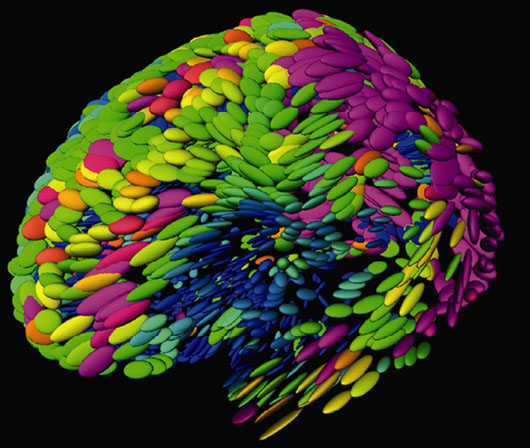TEDx MidAtlantic 2010: What if?

This year’s stellar TEDx MidAtlantic was about our choices and roles relative to our true selves, and relative to the world around us. “What if?” was the theme, and the talks seemed to focus on what parts of our brain we consciously choose to use. In fact, images of brains cropped up repeatedly in presentations throughout the day.
“Amazingly, there are cells in our left hemisphere’s orientation association area that define the boundaries of our body – where we begin and where we end relative to the space around us. At the same time, there are cells in our right hemisphere’s orientation association area that orient our body in space. As a result, our left hemisphere teaches us where our body begins and ends, and our right hemisphere helps us place it where we want to it go.”
– Jill Bolte Taylor, TED speaker, from her book, My Stroke of Insight.
Here are some of the What If’s that the speakers left us to ponder:
What if…..
You strive to be a big picture thinker?
You strive to keep your love of learning?
You embrace failure?
You find and use your own voice?
You bring every aspect of your life’s passions to bear in your work?
You focus on the business of happiness?
You strive to keep your sense of wonder?
You look at the world around you with new eyes?
You inspire and reward those around you to think creatively?
You use collective consciousness to solve big problems?
You create and build something lasting?
You give yourself space to breathe?
TEDx Resources
- TEDxMidAtlantic
- TEDxMidAtlantic on Twitter, #tedxmid #tedx
- TEDxMidAtlantic on Facebook
- TEDx MidAtlantic on Flickr
- TEDx site
- Main TED site
TEDx MidAtlantic 2010 Buzz
- Bmore Media, @BmoreMedia, Asking and Answering “What If?” at TEDx MidAtlantic
- The City Fix, @TheCityFix, Live Blogging TEDxMidAtlantic
- Roman Kudryashov, What are these ideas and why are they here? TEDx MidAtlantic, a brief summary
- Think Tank Creative, @think_tank, Live Blog: TEDxMidAtlantic
Speakers/Performers: (Twitter, URLs)
- Francis Béland, iprizecleanoceans.org
- Jeffrey Brown, @JeffreyBrown, www.pbs.org/newshour
- Steve Case, @SteveCase, http://revolution.com, www.casefoundation.org
- Storm Cunningham, @restorm, www.revitaliz.com
- Dickson Despommier, www.verticalfarm.com
- Esther Dyson, @edyson, http://edventure.com
- Nina Fefferman, www.rci.rutgers.edu/~feffermn
- David Gallo, @gallotar, www.whoi.edu
- Christoph Gielen, www.christophgielen.com
- Yash Gupta, http://carey.jhu.edu
- Cesar Harada, http://cesarharada.com
- Bill James, www.jpods.com
- Michael Kahn, www.shakespearetheatre.org
- Paula Kerger, www.pbs.org
- Diana Laufenberg, @dlaufenberg, www.scienceleadership.org
- Ted Leonsis, @TedLeonsis, www.verizoncenter.com
- Charles Limb, www.hopkinsmedicine.org
- Albert Yu-Min Lin, http://exploration.nationalgeographic.com/mongolia
- Tim McDonald, www.onionflats.com
- Matt Mountain, www.stsci.edu/portal
- Iyeoka Ive Okoawo, @iyeoka, www.iyeoka.com
- Sandra Postel, www.globalwaterpolicy.org
- Adam Pruden, www.mit.edu
- Otis Rolley, @OtisRolley, www.updconsulting.com
- Saras Sarasvathy, www.effectuation.org
- Jackie Savitz, @JackieSavitz, http://na.oceana.org
- Susan Shaw, www.meriresearch.org
- Sam Shelton, www.designigniteschange.org
- Roshini Thinakaran, http://roshinithinakaran.com
- Time for Three, @tf3, http://tf3.com
Related posts
- TEDxPotomac: A River Runs Through It
- New Year’s Resolutions: The Magnetic Poetry of TEDx MidAtlantic
- Twelve Everyday Health Rules–From 1908
Image:
Composite image of brain MRIs
Using computer software programs, scientists combined brain MRIs from 20 normal people into this composite image, in which ellipsoids represent normal anatomical variations. Pink purple ellipsoids, signifying the greatest variation, occur in brain regions that are uniquely human for example, regions that control language and logical reasoning. Blue ellipsoids, representing slight variations, occur in brain regions that control sensation and movements. Ultimately, this baseline data on interpersonal variability will allow scientists to distinguish normal anatomical variation from abnormal brain loss, such as that seen in Alzheimer’s disease. Image courtesy of Dr. Paul Thompson, University of California, Los Angeles. Grant No. EB001561, from the picture gallery of the National Institute of Biomedical Imaging and Bioengineering, National Institutes of Health.










Trackbacks & Pingbacks
[…] This post was mentioned on Twitter by Carol Torgan, Ph.D., TEDxSecondCity. TEDxSecondCity said: TEDx News: TEDx MidAtlantic 2010: What if? http://ht.ly/19X1Pj […]
Leave a Reply
Want to join the discussion?Feel free to contribute!